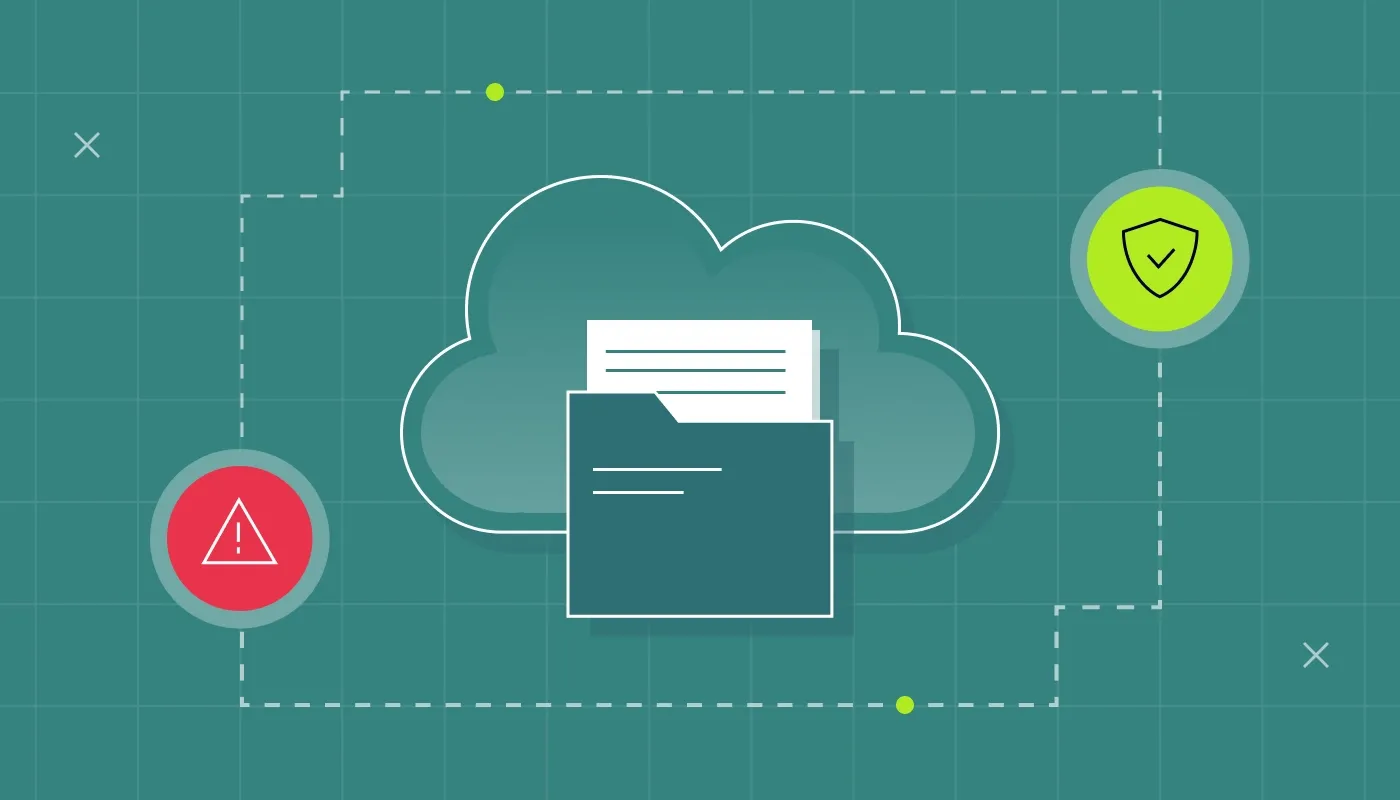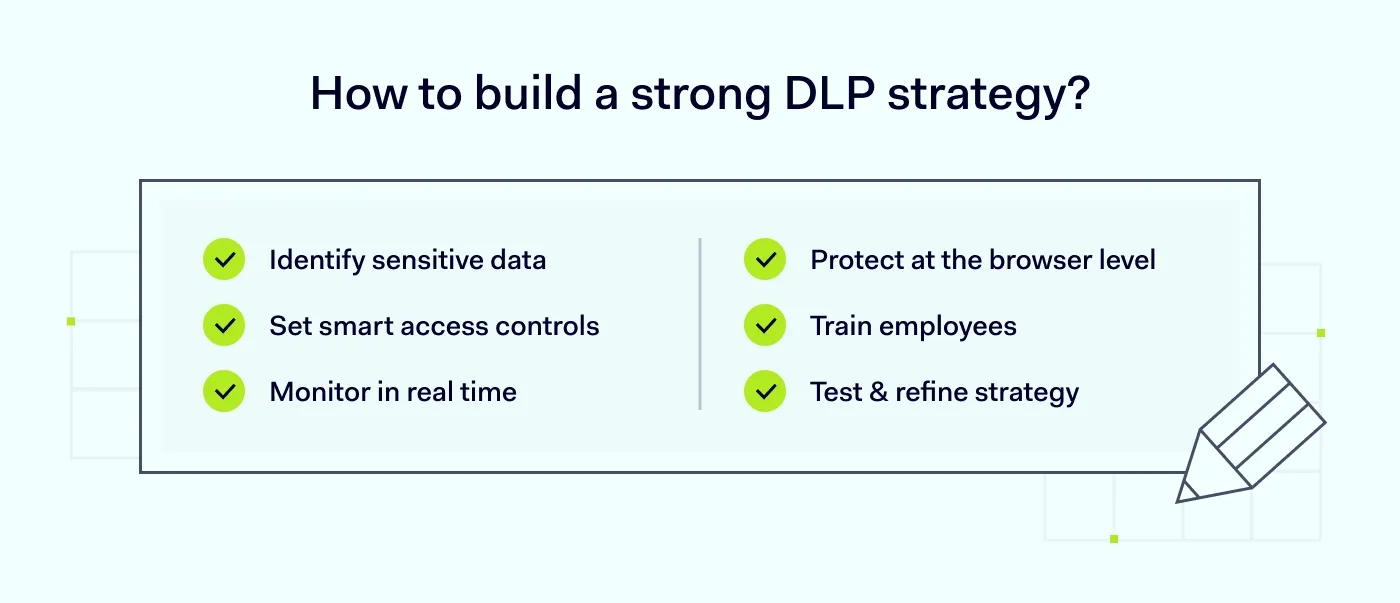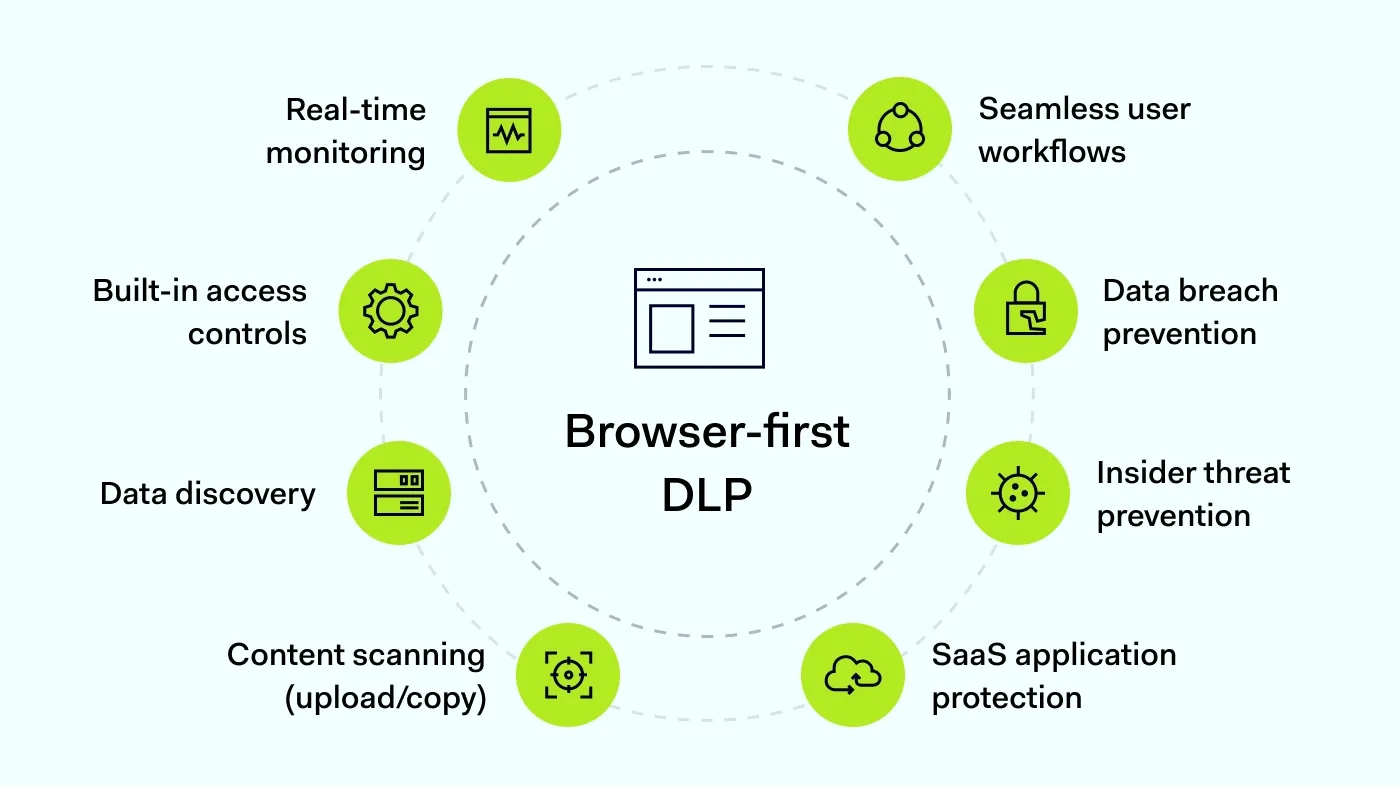Summary: SaaS Data Loss Prevention (DLP) is essential for businesses. Explore best practices, common mistakes, and modern solutions to protect sensitive data.
Software as a Service (SaaS) applications are the nervous system of modern organizations. They send emails, move files, manage deadlines, and store the knowledge that keeps teams alive and moving. Inside them sit various sensitive data, including confidential contracts and unreleased product roadmaps. If it ends up exposed, the damage can ripple far beyond a single lost document. That’s why Data Loss Prevention (DLP) for SaaS has become one of the most urgent security priorities.
A single reused password, a well-crafted phishing link, or one misconfigured permission can turn a minor slip into a full-scale breach. Therefore, DLP policies serve as the seatbelt for your company’s most valuable assets, with the enterprise browser becoming a frontline defender.
In this guide, we’ll break down why SaaS DLP is so challenging, where the real risks hide, and how to put the right DLP solutions for data protection in place.
Why SaaS needs its own DLP strategy
SaaS applications have transformed how businesses operate, because they are flexible and can easily grow with a company’s needs. They make it a breeze for global teams to collaborate, but this convenience also comes at a cost: sensitive data is often stored and accessed outside the traditional network perimeter. What used to be centralized and easier to control is now scattered across dozens of platforms.
This shift introduces more entry points for insider threats, accidental leaks, or human error. A misplaced file or misdirected email in SaaS applications can open the door to an entire chain of sensitive data. That’s why companies need to think beyond on-premises tools and build a dedicated SaaS DLP framework.
29% of companies suffered a SaaS data breach
in the past year, up 5% from the year before. This shows attackers are targeting cloud-based workflows rather than just local systems.
28% of businesses had a cloud- or SaaS-related breach, and
36% of them were hit more than once. Repeat attacks prove that once sensitive data is exposed, cybercriminals often come back for more.
SaaS breaches
spiked 300% in 2024, with some attackers going from compromise to data exfiltration in
as little as nine minutes. Speed is now a weapon, leaving little room for manual detection.
For executives, those statistics should be warning signs. A single SaaS breach can leak customer details, financial reports, or intellectual property. And because many industries face strict compliance rules, the financial and reputational damage can be twice as bad.
That’s why Data Loss Prevention can’t stop at devices or the corporate network. For comprehensive data protection, it must extend into the SaaS layer. This allows to discover and classify sensitive information, monitor its movement, and stop leaks before they spiral into costly data breaches.
Why SaaS DLP is so hard to implement
Knowing you need SaaS DLP is one thing. Putting it into practice is another. Many businesses underestimate the hidden complexity of SaaS environments. Apps are easy to adopt but hard to secure consistently. Here’s why organizations often struggle:
Endless apps and shadow IT
Most companies rely on dozens, or even hundreds, of SaaS applications. Teams adopt apps for convenience, but not all are IT-approved. This shadow IT creates blind spots, storing sensitive data in places security teams don’t even know about. Without a clear DLP policy across all applications, you can’t enforce proper access controls or stop leaks.
Poor visibility into data flows
SaaS data doesn’t sit still. It moves between apps, devices, and external collaborators, often without a clear audit trail. This lack of visibility is especially risky for insider risk management, since unusual data transfers may go unnoticed until it’s too late. Continuous monitoring is the only way to detect early warning signs and keep sensitive data safe.
Identity as the weakest link
In SaaS, identity is often the key. A stolen password or hijacked session can unlock multiple apps at once. Because identity-based attacks are so effective, insider threats and compromised accounts remain the leading cause of SaaS data breaches. Without strong access controls, even one mistake can cascade across your entire ecosystem.
Lack of collaboration across departments
Collaboration across departments is often overlooked. While IT and security teams might set up DLP policies, they need input from HR, legal, and compliance to tailor policies to specific data types and regulatory requirements. This cross-functional collaboration is vital for creating a strong, organization-wide DLP strategy that addresses risks in real-time.
Legacy DLP tools can’t keep up
Traditional DLP tools were designed for on-premises servers and email. They rarely detect SaaS-specific actions like copying text from a browser window or uploading sensitive data into an unapproved app. This is where modern DLP solutions come in, offering browser-level enforcement, smarter data classification, and tighter integration with SaaS applications.
The result? Higher insider threats, faster-moving data breaches, and increased compliance risks when sensitive data slips through. SaaS DLP requires modern approaches, not outdated checklists.
Keep your data safe: get the DLP guide
Simple steps to protect sensitive data, prevent breaches, and stay compliant
Common mistakes in SaaS DLP implementation
Despite understanding the importance of Data Loss Prevention (DLP) for SaaS applications, many organizations still make common mistakes that hinder effective protection of sensitive data. Some of these missteps can lead to security gaps, making it easier for cybercriminals to exploit vulnerable points.
Lack of comprehensive visibility
One common mistake is not having full visibility over all SaaS apps in use. Shadow IT can leave organizations blind to the presence of apps that house sensitive data. By failing to track and monitor app usage, businesses inadvertently create opportunities for data breaches.
Inconsistent access controls
Another mistake is applying inconsistent or outdated access control policies across various platforms. Without a clear policy for each SaaS app, businesses risk giving unauthorized users access to sensitive information, leading to potential insider risks. It's crucial to set role-based access controls and continuously enforce the principle of least privilege.
Over-reliance on legacy DLP tools
Many organizations use outdated DLP solutions that were originally designed for on-premises data. These legacy tools often miss the mark when it comes to cloud applications. To adequately protect SaaS environments, companies need modern DLP solutions that are tailored to the cloud.
From awareness to action: Best practices for SaaS DLP
Awareness alone won’t protect sensitive data. To truly secure SaaS applications, businesses need structured, ongoing practices.
A comprehensive SaaS DLP strategy helps prevent data breaches, ensures smoother compliance, and builds confidence across the organization. Here's how:
1. Identify sensitive information
You can’t protect what you can’t see. Start by scanning all SaaS applications for sensitive data: customer records, financial reports, payment details, or intellectual property. Data discovery tools help automate this process, ensuring nothing slips through the cracks. Once identified, apply data classification to rank information by risk: public, restricted, confidential, or critical. This step builds the foundation of Data Loss Prevention, ensuring the right protections are applied without disrupting workflows.
2. Set smart access controls
Once your sensitive data is mapped, control who can access it. Role-based access control (RBAC) is essential here, as permissions should match an employee’s specific job function, not their title or seniority. Apply the “least privilege” principle, ensuring users only have the minimum access needed to perform their tasks. This is one of the simplest and most effective SaaS DLP measures to reduce the risk of accidental data leaks or malicious insider activity. Even trusted employees shouldn’t have unrestricted access to move sensitive data between SaaS applications without oversight.
3. Monitor SaaS activity in real time
With policies in place, the next step is visibility. Continuous monitoring tools track user behavior inside SaaS applications, flagging unusual patterns like mass downloads, suspicious copy-paste activity, or sharing data with unauthorized apps. Real-time alerts allow you to investigate potential threats instantly rather than discovering a data breach days or weeks later. This proactive approach to data security turns monitoring into a protective shield for your entire SaaS stack.
4. Stop data leaks at the browser level
Many SaaS-related data breaches start in the browser, where sensitive data is copied, uploaded, or sent without authorization. Traditional Data Loss Prevention tools, which focus on endpoints or email, often miss these events entirely. A business browser with integrated SaaS DLP can block risky actions at the exact point of interaction before sensitive data ever leaves your environment. This approach enforces policies directly in the workflow, without requiring extra plugins or disruptive software installations.
5. Train your people, not just systems
Even the best DLP solutions fail if employees don’t understand their role in data protection. Employees need to understand why data security matters, what counts as sensitive data, and how to spot potential threats. Offer regular, engaging training sessions that cover phishing awareness, safe data sharing practices, and the dangers of bypassing approved SaaS applications. When employees understand the “why” behind the rules, regulatory compliance rates rise and accidental data breaches drop.
6. Test, update, and refine your DLP strategy
Cyber threats don’t stand still, and neither should your SaaS DLP approach. Regularly review your security logs, run simulated breach tests, and update your policies as new SaaS applications or data types enter your ecosystem. Fine-tune alerts to avoid false positives. By continuously improving your Data Loss Prevention framework, you ensure that your sensitive data stays protected against today’s and tomorrow’s attack methods.
Related articles

Joanna KrysińskaMar 20, 202512 min read

Joanna KrysińskaAug 30, 20249 min read
What matters most when setting up SaaS DLP
A good SaaS Data Loss Prevention strategy is more than a set of rules. It’s a living system that adapts to how your business works, how your people collaborate, and how threats evolve. The right setup doesn’t just stop data breaches; it also fits naturally into everyday workflows so security becomes second nature, not a roadblock.
The first step to protecting sensitive data in SaaS applications is visibility. Knowing exactly which apps are in use is key: not just the ones IT approved, but also the “shadow” apps actually in use. True visibility lets you trace how sensitive data moves, detect anomalies, and stop leaks before they turn into full-blown data breaches.
Smarter data classification
Smarter data classification is equally critical. Not all information carries the same risk. Financial reports, customer records, and intellectual property demand tighter controls than public marketing materials. That’s where automated tagging and classification come in. The more accurately your DLP solutions can identify sensitive data across SaaS applications, the faster they can enforce policies without slowing down productivity.
However, even perfectly classified data is at risk if the accounts accessing it are not secure. The majority of SaaS data breaches still begin with compromised accounts, whether that’s a stolen password, an abused API key, or misconfigured permissions. A strong DLP program must protect not only human identities but also machine accounts and automated processes that connect different SaaS tools. When identity security is baked into your DLP solutions, one stolen login won’t open the floodgates to your entire SaaS stack.
Enforcing security where work happens
Finally, enforcement needs to happen where work happens—in the browser. SaaS applications live there, so your DLP should, too. By enforcing data protection directly in the browser, you can catch risky behavior the moment it happens, whether it’s a copy-paste into an unapproved app, a file upload to a personal drive, or a suspicious download. Using a corporate browser, companies can apply DLP solutions directly within SaaS workflows, ensuring compliance without frustrating employees. This is where SaaS DLP moves from being a data security add-on to a natural part of daily work.
In regulated industries, stopping breaches is one thing, because you also need to prove you’ve done it. Detailed audit logs, real-time alerts, and comprehensive reporting make regulatory compliance easier and less stressful. With the right DLP solutions in place, you can show auditors exactly how sensitive data is handled, when incidents happened, and how they were resolved.
Built to flex and grow
No two pieces of data are alike, and your policies shouldn’t treat them as if they are. Your DLP strategy needs to adapt by applying strict controls to high-risk information while allowing more unrestricted movement for data that supports collaboration. And as your SaaS footprint expands, your DLP solutions should scale seamlessly, covering new applications without weeks of reconfiguration.
SaaS DLP stops being a standalone tool and becomes an integral part of your business resilience strategy. This happens when all these elements work together: visibility, classification, identity security, in-browser enforcement, compliance, and scalability.
The modern approach of browser-first DLP
For years, Data Loss Prevention tools were built to guard local files and corporate email. But today, the real action (and the real risk) lives in the browser. Employees use SaaS applications for everything from sharing contracts to handling customer data, and the browser has become the front door to nearly every business workflow. It’s also the place where most sensitive data now moves, transforms, and, if left unprotected, leaks out.
This is where traditional DLP solutions fall short. Legacy systems rarely see what happens inside a browser tab. They miss copy-and-paste into a personal email account, uploading sensitive financial records into an unapproved storage app, or pasting customer data into a chat tool that isn’t approved by IT. And when they do try to catch it, they often slow users down or block legitimate work.
A browser-first DLP approach solves this by moving the security perimeter right to where the work happens. A corporate browser is built from the ground up with Data Loss Prevention in mind. It integrates access controls, data discovery, and content scanning into the daily workflow, monitoring risky actions like unauthorized uploads, copying text with sensitive data, or sending files to an unsanctioned SaaS application, all in real time.
With browser-level visibility, IT teams can enforce DLP policies instantly. This reduces insider threats, cuts down on data breaches, and improves data security without forcing employees to jump through hoops. The result: fewer risks, smoother workflows, and stronger protection of sensitive data.
Introducing NordLayer’s Enterprise Browser
At NordLayer, we see the browser as the new frontline for SaaS DLP. That’s why we’re developing a new-gen browser designed to handle the unique challenges of SaaS applications. It’s not just another add-on to consumer browsers. Rather, it’s a purpose-built tool for security and productivity.
With NordLayer’s Enterprise Browser, you can expect:
Real-time protection and enforcement. Data protection happens at the exact moment it’s handled. Whether it’s stopping a spreadsheet from being uploaded to an unauthorized SaaS application or blocking sensitive customer details from being pasted into a chat, the browser enforces SaaS DLP policies in real time.
Seamless integration with existing controls. The browser works alongside DLP solutions and access control systems you already use, improving your network security without extra overhead.
Comprehensive SaaS coverage. Whether your team works in approved tools or occasionally drifts into shadow IT, the browser gives IT teams visibility into unapproved activity so they can track and address risky data flows before they become a problem.
We’re currently inviting companies to join the Enterprise Browser waitlist and help shape the new generation of SaaS security. It’s a chance to strengthen data protection at the point of interaction with SaaS applications.
Protecting SaaS with NordLayer: What to expect
You don’t have to wait for the Enterprise Browser to start protecting your SaaS applications and sensitive data with NordLayer. Our platform offers a robust security suite that helps prevent data breaches and mitigate insider threats.
With NordLayer, you can:
When you combine these capabilities with Data Loss Prevention policies, you can create a SaaS security environment that’s not just strong, but easy to manage. Sensitive data stays secure, your team works without unnecessary roadblocks, and your SaaS stack becomes a much harder target for attackers.
FAQs
What is SaaS DLP?
SaaS Data Loss Prevention (DLP) is a security approach designed to protect sensitive information stored and shared within cloud-based applications, such as Google Workspace, Microsoft 365, or Slack. Unlike traditional DLP, which focuses on endpoints or on-premises networks, SaaS DLP monitors, classifies, and restricts the movement of data both inside and outside these platforms. Its goal is to reduce the risk of accidental exposure or intentional leaks that could lead to costly data breaches.
What are the three types of DLP?
Generally, DLP is divided into three categories: endpoint DLP, which safeguards data on devices such as laptops or mobile phones; network DLP, which monitors and controls information flowing across company networks; and cloud or SaaS DLP, which protects information in cloud applications. Together, they create a layered defense strategy, ensuring data remains secure no matter where it resides or how it is accessed.
What is DLP in cloud computing?
In cloud computing, DLP extends traditional safeguards into virtual environments. It applies policies to detect sensitive data, such as personal identifiers or financial details, and prevents unauthorized sharing outside the organization. Since cloud services are widely used by remote and hybrid teams, cloud DLP helps organizations maintain compliance and reduce risks of data breaches in environments they don’t fully own.
What is SaaS data protection?
SaaS data protection refers to practices and tools that keep information safe within software-as-a-service platforms. It includes encryption, backup, access controls, and data loss prevention measures. Because SaaS tools are often used for collaboration, protecting data in these environments is critical to prevent leaks or exposure.
What is SaaS in cybersecurity?
In cybersecurity, SaaS (Software as a Service) means cloud-hosted applications delivered over the internet. These services require additional layers of protection because employees rely on them daily to handle sensitive data. Without proper controls, SaaS platforms can become a common target for attackers.

Agnė Srėbaliūtė
Senior Creative Copywriter
Agne is a writer with over 15 years of experience in PR, SEO, and creative writing. With a love for playing with words and meanings, she crafts content that’s clear and distinctive. Agne balances her passion for language and tech with hiking adventures in nature—a space that recharges her.











